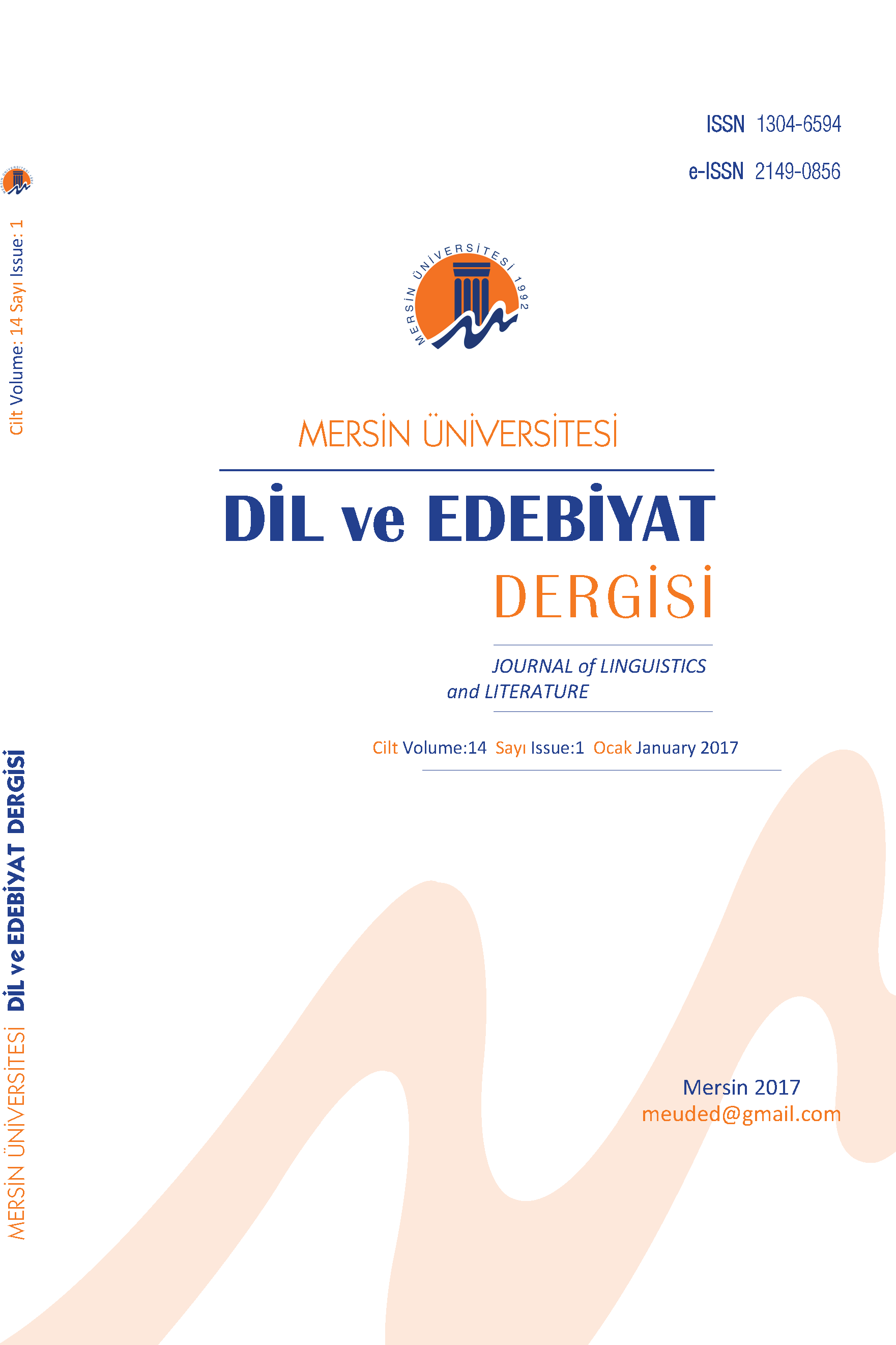Evlenilecek Kadın ve Evlenilecek Erkek Kimdir Sorusuna Etkileşimsel Bir Yanıt: Üyelik Kümeleme Çözümlemesi
Bu makale izleyicilerin ‘evlilik kadını’ ve ‘evlilik erkeği’ olarak nitelendirdikleri toplumsal ulamların etkileşim içinde konuşma esnasında yeniden yapılandırılmasını ve pekiştirilmesini incelemektedir. Bu çalışmada kullanılan bütünce Türkiye’de son on yılda çok popülerlik kazanmış olan evlilik programlarını izlemekte olan Türk kadınlarının video kayıt altına alınmış etkileşimlerinden oluşmaktadır. Üyelik Ulamla Çözümlemesi (ÜUÇ) etkileşimde kullanılan dil ve toplumsal ulamlar arasındaki ilişkinin ortaya çıkarılması için kullanılmıştır. Konuşma Çözümlemesi yöntemiyle aynı budun yöntembilim ilkelerene bağlı kalan ÜUÇ yöntemi toplumsal ulamların etkileşim içinde empirik bir şekilde incelenebilmesine olanak sağlar. Yapılan çözümlemelerde. izleyicilerin televizyon izleme esnasında toplumsal ulamları özellikle yaptıları değerlendirmelerle yeniden yapılandırdığını görüyoruz. ‘Evlilik kadını ve ‘evlilik erkeği’ ulamlarını yapılandırırken izleyicilerin Schegloff (1991)’un daha önce belirttiği ÜUÇ yönteminin iki önemli özelliği: 1) ulamlara bağlı etkinlikler ve 2) dış etmenlere karşı kendini koruma eğilimi yapılan çözümlemerde ‘evlilik erkeği’ ve ‘evlilik kadını’ ulamlarına bağlı olarak gösterilmiştir.Anahtar Sözcükler: Üyelik ulamlama çözümlemesi, evlilik programları, toplumsal ulamlar
Anahtar Kelimeler:
Üyelik ulamlama çözümlemesi, evlilik programları, toplumsal ulamlar
___
- Baker, C. D. (2004). Membership categorization and interview accounts. In D. Silverman (Ed.), Qualitative Research: Theory, Method and Practice. (pp. 162–176). London: SAGE.
- Cameron, D. (1998). Gender, Language, Discourse: A review essay, Journal of Women in Culture and Society, 23(4), 945-973.
- Edley, N. & Wetherell, M. (1997). Jockeying for position: The construction of masculine identities, Discourse & Society, 8(2), 203-217.
- Edwards, D. and Potter, J. (2012). Descriptions and Assessments. Plenary talk given Conference University. Loughborough
- Fishman, P. M. (1983). Interaction: The Work Women Do. In B. Thorne, C. Kramarae and N. Henley (Ed.), Language, Gender and Society. (pp. 89–101). Rowley, MA: Newbury House.
- Heritage, J. (1984). A change-of-state token and aspects of its sequential placement. In J. Atkinson, J. Maxwell, J. Heritage (Ed.), Structures of Social Action: Studies in Conversation Analysis. (pp. 299-345). Cambridge: Cambridge University Press.
- Heritage, J. (1998). Oh-prefaced responses to inquiry, Language in Society, 27, 291-334.
- Heritage, J. (2005). Conversation analysis and institutional talk. In K. Fitch and R. Sanders (Ed.), Handbook of Language and Social Interaction. (pp. 103–147). Mahwah, NJ: Lawrence Erlbaum.
- Hutchby, I. & Wooffitt, R. (2008). Conversation analysis. Polity Press.
- Hester, S. & Eglin, P. (1997). Culture in Action: Studies in Membership Categorization Ethnomethodology and University Press of America. Boston, MA: International Institute for
- Jefferson, G. (2004). “At first I thought”: A normalizing device for extraordinary events. In G. H. Lerner, (Ed.), Conversation Analysis: Studies from the first generation. (pp. 131-67). Amsterdam/Philadelphia: John Benjamins.
- Kessler, S. J. & McKenna, W. (1978). Gender: an ethnomethodological approach. New York: Wiley.
- Kitzinger, C. (2000). Doing feminist conversation analysis, Feminism and Psychology, 10, 163-93.
- Kitzinger, C. (2007). Feminist Conversation Analysis: Research by students at the University of York, UK, Feminism & Psychology, 17, 133-148.
- Lakoff, R. (1975). Extract from Language and Woman’s Place. New York: Harper.
- Pomerantz, A. (1984). Agreeing and disagreeing with assessments: some features of preferred/dispreferred turn shapes. In J. Atkinson, J. Maxwell, J.Heritage (Ed.) Structures of Social Action: Studies in Conversation Analysis. (pp. 57-101). Cambridge: Cambridge University Press.
- Sacks, H. (1992). Lectures on conversation. 2 vols. Edited by Gail Jefferson with introductions by Emanuel A. Schegloff. Oxford: Basil Blackwell.
- Schegloff, E. A. (1991). Reflections on talk and social structure. In D. Boden, D.H. Zimmerman (Ed.) Talk and social structure: studies in ethnomethodology and conversation analysis. (pp. 44-70). Cambridge: Polity Press.
- Schegloff, E. A. (2007). A tutorial on membership categorization, Journal of Pragmatics, 39, 462-82.
- Silverman, D. (1998). Harvey Sacks: Social Science and Conversation Analysis. Cambridge: Polity Press.
- Silverman, D. (2001). Interpreting Qualitative Data: Methods for Analysing Talk, Text and Interaction. London: SAGE.
- Silverman D. (2012). Beyond armed camps: A response to Stokoe, Discourse Studies, 14(3), 329-336.
- Speer, S. A. (2005). The interactional organization of the gender attribution process, Sociology, 39, 67-87.
- Speer, S. A. & Stokoe, E. (2011). Conversation and Gender. Cambridge: Cambridge University Press.
- Spender, D. (1980). Man Made Language. Routledge & Kegan Paul.
- Stokoe, E. (2000). Towards a conversation analytic approach to gender and discourse, Feminism and Psychology, 10, 552-63.
- Stokoe, E. (2003). Mothers, single women and sluts: gender, morality and membership categorisation in neighbour disputes, Feminism and Psychology, 13(3), 317-44.
- Stokoe, E. (2006). On ethnomethodology, feminism, and the analysis of categorial reference to gender in talk-in-interaction, Sociological Review, 54(3), 467-94.
- Stokoe, E, (2012). Moving forward with membership categorization analysis: Methods for systematic analysis, Discourse Studies, 14(3), 277-303.
- Stokoe, E. (2012). Categorial systematics, Discourse Studies, 14(3), 345-354.
- Stokoe, E. H. & Smithson, S. (2001). Making gender relevant: conversation analysis and gender categories in interaction, Discourse & Society, 12, 243-69.
- Streeck, J., Goodwin, C. & LeBaron, C. (Ed.) (2011). Embodied interaction: language and body in the material world. Cambridge: Cambridge University Press [Series: Learning in Doing: Social, Cognitive and Computational Perspectives]
- Tannen, D. (1991). You Just Don‟t Understand: Women and Men in Conversation. London: Virago.
- Uchida, A, (1992). When “difference” is “dominance”: A critique of the “anti-power-based” cultural approach to sex differences, Language in Society, 21(4), 547-568.
- Weatheral, A. (2002). Towards understanding gender and talk-in-interaction, Discourse & Society, 13(6), 767-781.
- Wiggins, S. & Potter, J. (2003). Attitudes and evaluative practices: Category vs. item and subjective vs. objective constructions in everyday food assessments, British Journal of Social Psychology, 42, 513–31.
- Whitehead, K. A. (2009). ‘Categorizing the categorizer’: The management of racial common sense in interaction, Social Psychology Quarterly, 72(4): 325–342.
- ISSN: 1304-6594
- Yayın Aralığı: Yılda 2 Sayı
- Başlangıç: 2004
- Yayıncı: Mersin Üniversitesi
Sayıdaki Diğer Makaleler
Tartışmada Örtüşme ve Örtüşmelerin Çözümü
Televizyon Röportajında Sorun, Gerilim ve Kışkırtma
İrem ONURSAL AYIRIR, étienne MARGET
Olcay SERT, Ufuk BALAMAN, Nilüfer CAN DAŞKIN, Safinaz BÜYÜKGÜZEL, Hatice Ergül
Standart Hasta-Tıp Öğrencisi Etkileşiminde Ön Bilgi İddiaları ve Etkileşimsel Sorunlar
